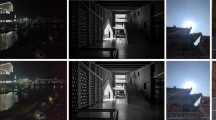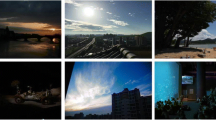Abstract
It has become more convenient to take photographs in our daily life. However, without sufficient skills, we often produce poor photographs with low contrast and unclear details under various imperfect illumination conditions. Although plenty of image enhancing models have been developed, most of them impose a uniform enhancing strength to the whole image region, and thus tend to generate over-enhancement effects for regions with originally-satisfying illumination. To address this issue, we propose a novel contrast enhancing model, which is a simple linear fusion process based on an original image and its initial enhancement. As the key of our model, we construct a lightness map that estimates the scene lightness, which is aware of the image structure at pixel-wise level. In the fusion process, this map dynamically weighs between the initially enhanced image and the original image, and thus ensures a seamless fusion result. In our experiments, we validate our model on images with various illumination conditions, such as strong back light, imbalanced light, and low light. The results empirically show that our model performs well on simultaneously improving image contrast and keeping its naturalness.









Similar content being viewed by others
References
Chen Y, Klopp J, Sun M, Chien S, Ma K (2017) Learning to Compose with Professional Photographs on the Web. In: Proceedings of ACM Multimedia (ACM MM)
Cheng G, Yang C, Yao X, Guo L, Han J (2018) When deep learning meets metric learning: remote sensing image scene classification via learning discriminative CNNs. IEEE Trans Geosci Remote Sens. https://doi.org/10.1109/TGRS.2017.2783902
Deng Y, Loy C, Tang X (2017) Aesthetic-driven image enhancement by adversarial learning. arXiv:1707.05251v1
Deng Y, Loy C, Tang X (2017) Image aesthetic assessment: an experimental survey. IEEE Signal Process Mag 34(4):80–106
Dong X, Wang G, Pang Y (2011) Fast efficient algorithm for enhancement of low lighting video. Proc Int Conf Multimed Expo (ICME)
Feng Z, Hao S (2017) Low-light image enhancement by refining illumination map with self-guided filtering. Proc Int Conf Big Knowledge (ICBK)
Fu X, Zeng D, Huang Y, Liao Y, Ding X, Paisley J (2016) A fusion-based enhancing method for weakly illuminated images. Signal Process 129:82–96
Fu X, Zeng D, Huang Y, Zhang X, Ding X (2016) A weighted variational model for simultaneous reflectance and illumination estimation. Proc Comput Vision Pattern Recogn (CVPR)
Gao F, Yu J (2016) Biologically inspired image quality assessment. Signal Process 124:210–219
Guo Y, Wu G, Jiang J, Shen D (2013) Robust anatomical correspondence detection by hierarchical sparse graph matching. IEEE Trans Med Imaging 32(2):268–277
Guo Y, Gao Y, Shen D (2016) Deformable MR prostate segmentation via deep feature learning and sparse patch matching. IEEE Trans Med Imaging 35(4):1077–1089
Guo X, Li Y, Ling H (2017) LIME: low-light image enhancement via illumination map estimation. IEEE Trans Image Process 26(2):982–993
Han J, Zhang D, Cheng G, Liu N, Xu D (2018) Advanced deep-learning techniques for salient and category-specific object detection: a survey. IEEE Signal Process Mag 35(1):84–100
Han J, Quan R, Zhang D, Nie F (2018) Robust object co-segmentation using background prior. IEEE Trans Image Process 27(4):1639–1651
Hao S, Wang M, Hong R, Jiang J (2016) Spatially guided local Laplacian filter for nature image detail enhancement. Multimed Tools Appl 75(3):1529–1542
He K, Sun J (2015) Fast guided filter. ArXiv, abs/150500996
He K, Sun J, Tang X (2011) Single image haze removal using Dark Channel prior. IEEE Trans Pattern Anal Mach Intell 33(12):2341–2353
He K, Sun J, Tang X (2013) Guided image filtering. IEEE Trans Pattern Anal Mach Intell 35(6):1397–1409
Hong R, Zhang L, Tao D (2016) Unified photo enhancement by discovering aesthetic communities from Flickr. IEEE Trans Image Process 25(3):1124–1135
Hong R, Zhang L, Zhang C, Zimmermann R (2016) Flickr circles: aesthetic tendency discovery by multi-view regularized topic modeling. IEEE Trans Multimed 18(8):1555–1567
Lee C, Lee C, Kim C (2013) Contrast enhancement based on layered difference representation of 2D histograms. IEEE Trans Image Process 22(12):5372–5384
Ni B, Xu M, Wang M, Yan S, Tian Q (2013) Learning to photograph: a compositional perspective. IEEE Trans Multimed 15(5):1138–1151
Reza AM (2004) Realization of the contrast limited adaptive histogram equalization (CLAHE) for real-time image enhancement, journal VLSI signal processing system for signal. Image Video Technol 38(1):35–44
Song J, Zhang L, Shen P, Peng X, Zhu G (2016) Single low-light image enhancement using luminance map. Proc Chin Conf Pattern Recogn (CCPR)
Tan R (2008) Visibility in bad weather from a single image. Proc Comput Vision Pattern Recogn (CVPR)
Tao X, Zhou C, Shen X, Wang J, Jia J (2017) Zero-order reverse filtering. Proc Int Conf Comput Vision (ICCV)
Thung K, Raveendran P, Lim C (2013) Content-based image quality metric using similarity measure of moment vectors. Pattern Recogn 45(6):2193–2204
Thung K, Adeli E, Yap P, Shen D (2016) Stability-weighted matrix completion of incomplete multi-modal data for disease diagnosis. Proc Med Image Comput Comput Assist Interven (MICCAI)
Xu L, Yan Q, Xia Y, Jia J (2013) Structure extraction from texture via relative Total variation. ACM Trans Graph 31(6):Article 139
Yao X, Han J, Zhang D, Nie F (2017) Revisiting co-saliency detection: a novel approach based on two-stage multi-view spectral rotation co-clustering. IEEE Trans Image Process 26(7):3196–3209
Yi Z, Zhang H, Tan P, Gong M (2017) DualGAN: unsupervised dual learning for image-to-image translation. Proc Int Conf Comput Vision (ICCV)
Yin W, Mei T, Chen C, Li S (2014) Socialized mobile photography: learning to photograph with social context via mobile devices. IEEE Trans Multimed 16(1):184–200
Yu Z, Wu F, Zhang Y, Tang S, Shao J, Zhuang Y (2014) Hashing with list-wise learning to rank, In: proceedings of ACM SIGIR conference on research & development in information retrieval (SIGIR)
Yu Z, Yu J, Fan J, Tao D (2017) Multi-modal factorized bilinear pooling with co-attention learning for visual question answering. Proc Int Conf Comput Vision (ICCV)
Yu Z, Yu J, Xiang C, Fan J, Tao D (2018) Beyond bilinear: generalized multi-modal factorized high-order pooling for visual question answering. IEEE Trans Neural Netw Learn Syst. https://doi.org/10.1109/TNNLS.2018.2817340
Yue H, Yang J, Sun X, Wu F, Hou C (2017) Contrast enhancement based on intrinsic image decomposition. IEEE Trans Image Process 26(8):3981–3994
Zhang Q, Shen X, Xu L, Jia J (2014) Rolling guidance filter. Proc Eur Conf Comput Vision (ECCV)
Zhang L, Wang M, Nie L, Hong L, Rui Y, Tian Q (2015) Retargeting semantically rich photos. IEEE Trans Multimed 17(9):1538–1549
Zhang L, Wang M, Nie L, Hong R, Xia Y, Zimmermann R (2015) Biologically inspired media quality modeling. Proc ACM Multimed (ACM MM)
Zhang D, Meng D, Han J (2016) Co-saliency detection via a self-paced multiple-instance learning framework. IEEE Trans Pattern Anal Mach Intell 39(5):865–878
Zhang H, Shang X, Luan HB, Wang M, Chua TS (2016) Learning from collective intelligence: feature learning using social images and tags. ACM Trans Multimed Comput Commun Appl 13(1):Article 1
Zhu X, Huang Z, Cheng H, Cui J, Shen H (2013) Sparse hashing for fast multimedia search. ACM Trans Inf Syst 31(2):Article 9
Zhu X, Li X, Zhang S (2016) Block-row sparse Multiview multilabel learning for image classification. IEEE Trans Cybernet 46(2):450–461
Acknowledgements
The authors sincerely appreciate the efforts of the anonymous reviewers and their useful comments during the reviewing process. The research was supported by the National Nature Science Foundation of China under grant number 61772171, grant number 61702156, and grant number 61632007.
Author information
Authors and Affiliations
Corresponding author
Rights and permissions
About this article
Cite this article
Hao, S., Guo, Y. & Wei, Z. Lightness-aware contrast enhancement for images with different illumination conditions. Multimed Tools Appl 78, 3817–3830 (2019). https://doi.org/10.1007/s11042-018-6257-1
Received:
Revised:
Accepted:
Published:
Issue Date:
DOI: https://doi.org/10.1007/s11042-018-6257-1




